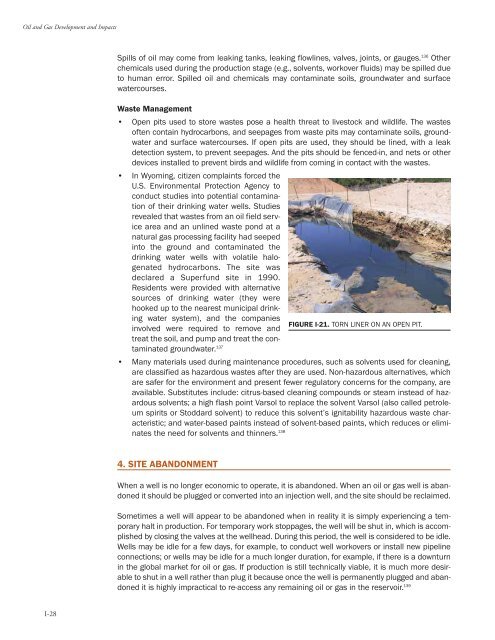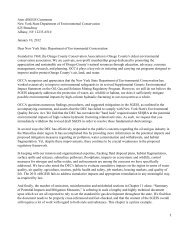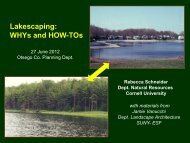Oil and Gas at Your Door? (2005 Edition) - Earthworks
Oil and Gas at Your Door? (2005 Edition) - Earthworks
Oil and Gas at Your Door? (2005 Edition) - Earthworks
You also want an ePaper? Increase the reach of your titles
YUMPU automatically turns print PDFs into web optimized ePapers that Google loves.
<strong>Oil</strong> <strong>and</strong> <strong>Gas</strong> Development <strong>and</strong> Impacts<br />
Spills of oil may come from leaking tanks, leaking flowlines, valves, joints, or gauges. 136 Other<br />
chemicals used during the production stage (e.g., solvents, workover fluids) may be spilled due<br />
to human error. Spilled oil <strong>and</strong> chemicals may contamin<strong>at</strong>e soils, groundw<strong>at</strong>er <strong>and</strong> surface<br />
w<strong>at</strong>ercourses.<br />
Waste Management<br />
• Open pits used to store wastes pose a health thre<strong>at</strong> to livestock <strong>and</strong> wildlife. The wastes<br />
often contain hydrocarbons, <strong>and</strong> seepages from waste pits may contamin<strong>at</strong>e soils, groundw<strong>at</strong>er<br />
<strong>and</strong> surface w<strong>at</strong>ercourses. If open pits are used, they should be lined, with a leak<br />
detection system, to prevent seepages. And the pits should be fenced-in, <strong>and</strong> nets or other<br />
devices installed to prevent birds <strong>and</strong> wildlife from coming in contact with the wastes.<br />
• In Wyoming, citizen complaints forced the<br />
U.S. Environmental Protection Agency to<br />
conduct studies into potential contamin<strong>at</strong>ion<br />
of their drinking w<strong>at</strong>er wells. Studies<br />
revealed th<strong>at</strong> wastes from an oil field service<br />
area <strong>and</strong> an unlined waste pond <strong>at</strong> a<br />
n<strong>at</strong>ural gas processing facility had seeped<br />
into the ground <strong>and</strong> contamin<strong>at</strong>ed the<br />
drinking w<strong>at</strong>er wells with vol<strong>at</strong>ile halogen<strong>at</strong>ed<br />
hydrocarbons. The site was<br />
declared a Superfund site in 1990.<br />
Residents were provided with altern<strong>at</strong>ive<br />
sources of drinking w<strong>at</strong>er (they were<br />
hooked up to the nearest municipal drinking<br />
w<strong>at</strong>er system), <strong>and</strong> the companies<br />
FIGURE I-21. TORN LINER ON AN OPEN PIT.<br />
involved were required to remove <strong>and</strong><br />
tre<strong>at</strong> the soil, <strong>and</strong> pump <strong>and</strong> tre<strong>at</strong> the contamin<strong>at</strong>ed<br />
groundw<strong>at</strong>er. 137<br />
• Many m<strong>at</strong>erials used during maintenance procedures, such as solvents used for cleaning,<br />
are classified as hazardous wastes after they are used. Non-hazardous altern<strong>at</strong>ives, which<br />
are safer for the environment <strong>and</strong> present fewer regul<strong>at</strong>ory concerns for the company, are<br />
available. Substitutes include: citrus-based cleaning compounds or steam instead of hazardous<br />
solvents; a high flash point Varsol to replace the solvent Varsol (also called petroleum<br />
spirits or Stoddard solvent) to reduce this solvent’s ignitability hazardous waste characteristic;<br />
<strong>and</strong> w<strong>at</strong>er-based paints instead of solvent-based paints, which reduces or elimin<strong>at</strong>es<br />
the need for solvents <strong>and</strong> thinners. 138<br />
4. SITE ABANDONMENT<br />
When a well is no longer economic to oper<strong>at</strong>e, it is ab<strong>and</strong>oned. When an oil or gas well is ab<strong>and</strong>oned<br />
it should be plugged or converted into an injection well, <strong>and</strong> the site should be reclaimed.<br />
Sometimes a well will appear to be ab<strong>and</strong>oned when in reality it is simply experiencing a temporary<br />
halt in production. For temporary work stoppages, the well will be shut in, which is accomplished<br />
by closing the valves <strong>at</strong> the wellhead. During this period, the well is considered to be idle.<br />
Wells may be idle for a few days, for example, to conduct well workovers or install new pipeline<br />
connections; or wells may be idle for a much longer dur<strong>at</strong>ion, for example, if there is a downturn<br />
in the global market for oil or gas. If production is still technically viable, it is much more desirable<br />
to shut in a well r<strong>at</strong>her than plug it because once the well is permanently plugged <strong>and</strong> ab<strong>and</strong>oned<br />
it is highly impractical to re-access any remaining oil or gas in the reservoir. 139<br />
I-28




